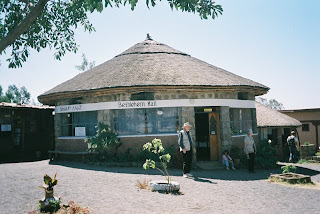Laoye gave us the wake-up call at 5:45 and we scrambled out of bed in the darkness, quickly dressed and headed to the dining hall for an early breakfast. By 7 we had brushed our teeth, packed the toothbrushes, and were ready for Abebe wo take us to the airport for the short flight from
In the airport bookstore I purchased an Ethiopian Christmas storybook (in English). It tells the story of Jesus's birth, with beautiful Ethiopian Orthodox style illustrations, and adds some extra detail about Jesus's time in
The flight to Lalibela took about 30 minutes. From the airplane we could see the torturous, mountainous terrain over which we'd driven the day before. Descending into lalibela it almost seems as though there is not enough flat space for the airplane to land, but then it touches down and all is fine.

Our guide for the next two days is Kasa, a fellow in his forties II would guess, so the oldest of our guides so far. Lalibela is a much smaller centre than either
And of course these tukuls are significantly more well-appointed than a traditional home. Half the tukul forms the bedroom, with (as usual) two twin beds. The other half is evenly split between a small sitting area and a spacious modern bathroom with glass-enclosed shower.
The hotel "lobby" and registration area is a somewhat more traditional style tukul, though with board walls and tin roof rather than euclyptus sticks and thatch.
This hotel provides breakfast only, so for lunch and dinner we walk down a side street to the Jerusalem Guest House where we eat our meals at the Bethlehem Hall, just across the road from the Heaven Guest House.
One might almost think one was in the
Indeed, we began our day's sightseeing activities with a visit to the northern group of stone-hewn churches. This is what makes Lalibela famous, drawing tourists from the earth's twelve quarters: the three groups of churches carved out of the mountains by man and angel, and which are still used today as sites of worship and prayer, gathering thousands of the faithful at Genna (Christmas – Jan 7) and Timkat (Epiphany – Jan 19). We will miss these celebrations, but that gives us the freedom to visit the churches without the teeming hordes.
If I recall correctly, the northern group of churches was first on our agenda, followed after lunch by the eastern group, with the
What can I say? After visiting some fifteen or twnety churches, the one blends into the other and none save the last stand our particularly. They are accessible via rough paths with many steps. Each church or groups of churches is surrounded by a carved "moat" representing the

Kasa said that the reason each church has a replica of the
Back to the churches… Some are fairly small, the three chambers little larger than a small room in a house though with higher ceilings, while others are much larger. All have somewhat rough floors covered with rugs worn with the passage of hundreds of feet. Curtains within the churches cover special paintings or frescoes and guard the entrance to the inner chamber. Inside each sat a white-robed priest, ready to display the cross for that particular church, as each has its own design. One is allowed to photograph the church interiors, priests and crosses to one's heart's content, even using flash as long as there are no frescoes inside that could be damaged by the flash. If one is using a video camera, one is required to pay 300 birr ($33) for the privilege, but normal cameras can be used at no charge. Unlike the round monastery church we saw at Bahir Dar, these are all rectangular, reflective of the influence of Catholocism on the earlier indigenous traditions. To get from one to another one must on occasion go through something of a tunnerl, or climb or descend steep passageways with many steps. At the entrance to each one must remove one's shoes, and a man is there who guards the shoes. Each shoe-guard attaches himself to a group and follows them throughout the complex, providing assistance over the rough passageways where required and providing good service, for which of course one is expected to pay at the end.
The
By the time we finished visiting Saint George, we were all quite worn out from the day's exertions. (Actually, for my part, while I was tired it wasn't bad, I have certainly been more tired and worn out on many an occasion.) Back at the hotel, we headed straight to the restaurant. Giggles was rather cranky, she was so worn out and tired, so I spoon-fed her some of my soup, which helped to lift her spirits somewhat. After supper we hopped into bed and gratefully rested our weary heads.
(Continue to 21 December: Lalibela - A Relaxing Day)



















No comments:
Post a Comment